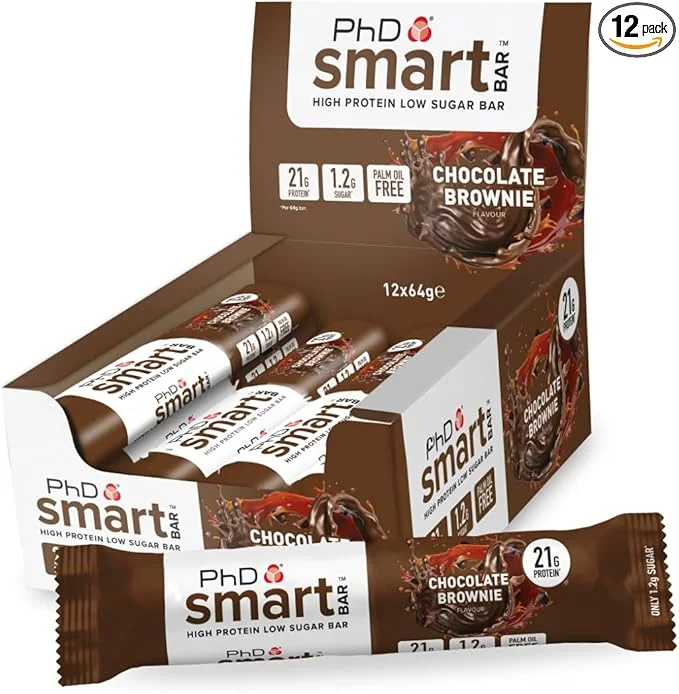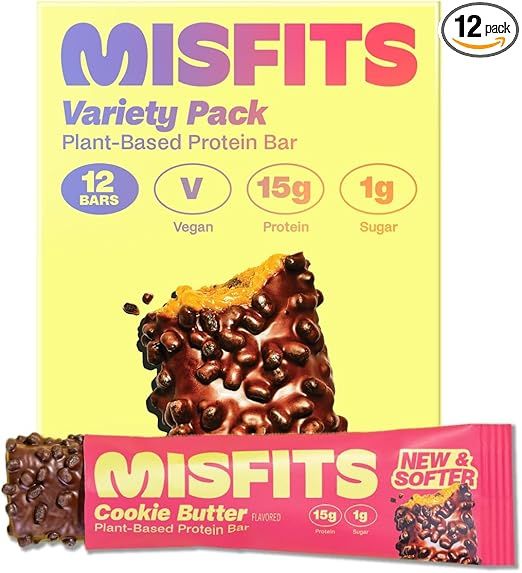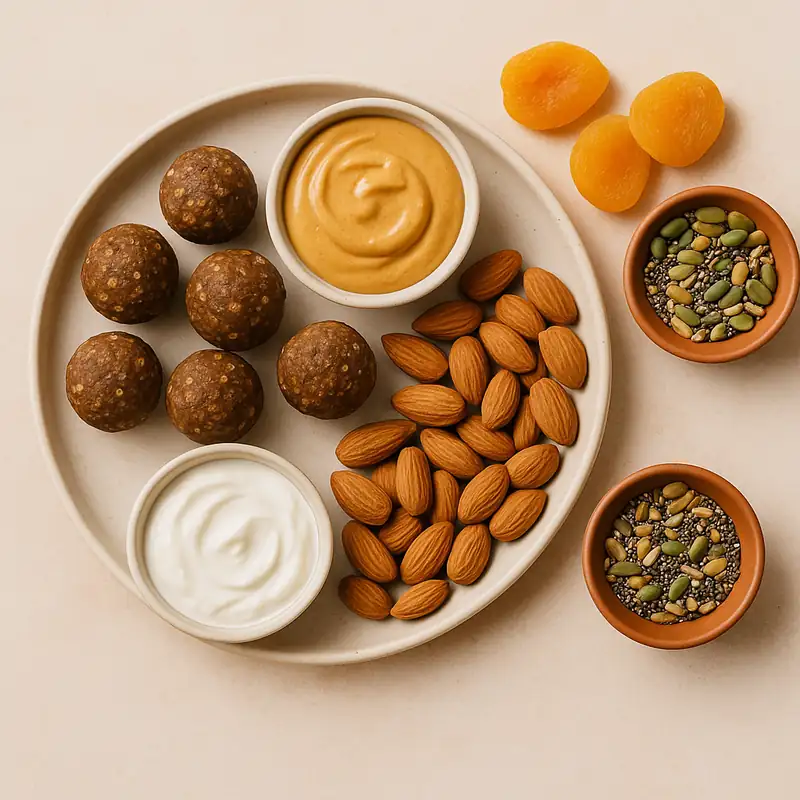Life moves fast, your snacks should keep up
You know the drill: breakfast is a blur, lunch arrives late, and by mid‑afternoon you’re rummaging through drawers for something, anything, to get you through to dinner. In moments like these, it’s all too easy to reach for a packet of crisps or a sugary biscuit because they’re convenient. But a little forethought can transform those snack breaks into delicious pit stops that deliver meaningful nutrition and make you feel human again. High‑protein snacks aren’t just for gym enthusiasts; they are everyday allies that help busy parents, office workers and students stay energised, curb cravings and, crucially, enjoy what they eat. This article explores how to turn humble ingredients into creative protein bites that feel indulgent, look Instagram‑worthy and support your wellbeing.
Protein deserves its moment in the spotlight because it helps you feel satisfied for longer, stabilises blood sugar and provides building blocks for muscles and tissues. When you weave modest amounts of protein into your snacks, you’ll notice that you’re less likely to raid the biscuit tin later or crash before a workout. Studies comparing high‑protein snacks with those based mainly on carbohydrates or fat have shown that the protein‑rich options delay hunger, extend the time to your next meal and help you maintain energy. If you’ve ever eaten a bag of crisps and felt hungry again ten minutes later, you’ll understand why protein matters. The good news? There are countless ways to sneak it in without resorting to chalky bars or bland shakes.
The power of the snack: small bites, big impact
Before we dive into recipes, it’s worth considering why snacks play such an important role in a balanced diet. Our lives aren’t always organised neatly into three sit‑down meals; we’re commuting, working from cafés, attending kids’ football practice or squeezing in a workout between errands. A thoughtful snack can bridge those unpredictable gaps, preventing energy slumps and helping you reach your daily protein goal. Research into appetite and satiety points to protein as a key player because it slows digestion, triggers fullness hormones and keeps blood sugar on an even keel. That’s why a handful of almonds or a pot of Greek yoghurt feels more satisfying than a handful of sweets.
High‑protein snacks also support muscle repair and recovery. You don’t need to be a bodybuilder to benefit from this; whether you’re carrying groceries up three flights of stairs, chasing toddlers in the park or recovering from a long cycle ride, your muscles are constantly being broken down and rebuilt. Giving your body a steady supply of amino acids helps that process along. Importantly, a protein‑forward snack doesn’t mean eating a steak between meals. The sweet spot tends to be 10–20 grams of protein delivered in a tasty, convenient format. What follows are ideas that mix sweet and savoury, familiar and surprising, and can be adapted to suit your tastes.
Unexpected flavour pairings
If you think high‑protein snacks are destined to be beige and boring, think again. Some of the most memorable bites come from pairing ingredients you might not have considered. Try a slice of toasted sourdough topped with cottage cheese and strawberries, drizzled with a whisper of balsamic vinegar. The creamy cheese supplies around 10 grams of protein per 100 grams, while the sweetness of the fruit and tang of vinegar make it taste like a treat. Another winning combination is crisp cucumber sticks dipped into a peanut–miso butter. Stir a teaspoon of white miso into a couple of tablespoons of smooth peanut butter, add a splash of lime juice and you’ll have a savoury dip that’s salty, nutty and utterly moreish. Peanut butter contributes around 7 grams of protein per two‑tablespoon serving and miso adds a savoury depth that makes raw veg exciting.
For something savoury with crunch, try crisped chickpeas. Drain a tin of chickpeas, pat them dry, toss with olive oil, sea salt and your favourite spices—smoked paprika and cumin work wonderfully—then roast until golden. A half‑cup serving of chickpeas contains roughly 7 grams of protein and a respectable amount of fibre. The result is a crunchy, portable snack that rivals crisps but leaves you feeling satisfied. You can achieve the same effect with edamame beans; toss frozen pods in sesame oil and chilli flakes, then roast until slightly crisp. They’re rich in protein and make excellent cinema snacks when you need something to nibble that isn’t popcorn.
DIY energy bites and bars
Energy balls and homemade bars have become staples in health‑conscious kitchens because they’re customisable, require no baking and are far cheaper than shop‑bought options. At their core, they combine a sticky element (dates, maple syrup or honey), a dry base (rolled oats or ground nuts) and a protein boost (powder, seeds or nut butter). The fun part is customising them to your flavour preferences. For a classic take, blitz together 150 grams of pitted dates, 100 grams of rolled oats, a scoop of your favourite protein powder and two tablespoons of almond butter until the mixture holds together. Roll into balls and coat in desiccated coconut or cocoa powder. Each one will deliver 4–5 grams of protein and a hit of fibre to keep you going.
If you prefer bars, press the mixture into a lined tin and refrigerate until firm before slicing. Swapping the almond butter for tahini or peanut butter changes the flavour profile, and adding spices such as cinnamon or ground ginger gives warmth. For a festive twist, fold in dried cranberries and orange zest. These bites are perfect for tucking into a handbag or gym bag and will spare you from expensive, sugar‑laden snacks on the go. They also freeze beautifully, so it’s worth making a double batch.
Savoury protein, sorted
While sweet snacks often steal the limelight, savoury options can be just as satisfying. In the UK, there’s a growing trend towards air‑fried pulses and roasted seeds. Keep a jar of spiced pumpkin seeds on your desk: simply toss raw seeds with a whisker of soy sauce, maple syrup and chilli, then toast until crisp. They’re addictive sprinkled over salads or eaten by the handful, and a 30‑gram portion provides around 9 grams of protein.
If you have a bit more time, consider making mini frittatas in a muffin tin. Beat six eggs with a splash of milk, season with salt and pepper, then stir in diced cooked vegetables, chopped spinach, smoked salmon or grated cheddar. Divide into greased muffin cups and bake until set. Each mini frittata packs about 5 grams of protein and can be stored in the fridge for quick breakfasts or midday nibbles. For an even quicker fix, stock packets of smoked salmon trimmings from the supermarket; they are affordable and pack a substantial 18 grams of protein per 100 grams. Spread them over wholegrain crackers smeared with a thin layer of soft cheese for a sophisticated yet easy snack.
Portable protein for busy days
On days filled with meetings, travel or school runs, portability is paramount. Hard‑boiled eggs are a classic for good reason: at roughly 6 grams of protein per egg, they’re nature’s ready‑made snack. Peel a few at the beginning of the week, sprinkle with a pinch of sea salt and smoked paprika, and you’ve got a mini meal to stave off hunger. If you’re vegan, consider roasted edamame or soy‑based snacks that are widely available in UK supermarkets; they provide comparable protein per serving and satisfy the need for something savoury and crunchy.
Another brilliant portable option is the mini jar salad. Layer a tablespoon of quinoa or lentils in the bottom of a small jar, add diced cucumbers, cherry tomatoes and shredded chicken or chickpeas, then finish with a spoonful of yoghurt‑based dressing. The layers stay crisp, the protein keeps you satisfied and the colours are delightful when you open the lid. When you need something sweet but still nourishing, pack a pouch of Greek yoghurt mixed with a swirl of honey and a handful of fresh berries. Choose the plain varieties and add your own fruit to avoid the hidden sugars often found in flavoured pots; a 150 gram serving can contain 15–20 grams of protein.
Protein snacks that kids will love
If you have little ones, you’ll know that they are discerning snackers. Fussy tastes and small appetites can make it tricky to keep their nutrition on track. Fortunately, there are playful ways to sneak extra protein into their snacks without them realising. Try “ants on a log”: celery sticks filled with peanut butter and dotted with raisins. The peanut butter provides healthy fats and protein, while the raisins add natural sweetness. For a chilly treat, blend Greek yoghurt with ripe bananas and strawberries, pour into lolly moulds and freeze; these protein popsicles are creamy, naturally sweet and far more balanced than many shop‑bought lollies.
Mini pancake skewers are another crowd‑pleaser. Make small, fluffy pancakes using a mixture of oats, eggs, mashed banana and a scoop of vanilla protein powder, then thread them onto skewers with slices of fruit. A drizzle of maple syrup or a yoghurt dip on the side turns snack time into an adventure. These ideas not only boost protein but also make snacking fun, encouraging children to try new flavours and textures. Pack them in lunchboxes or serve them after school when appetites are at their peak.
Pre‑ and post‑workout fuel
If exercise is part of your routine, timing your protein intake around workouts can support performance and recovery. About an hour before training, opt for a snack that combines easily digestible carbohydrates with a moderate amount of protein. A smoothie made with frozen mango, spinach, almond milk and a scoop of pea or whey protein is refreshing and provides a balance of energy and amino acids. For those who prefer solid food, a slice of wholegrain toast topped with mashed avocado and a poached egg offers a satisfying 12–15 grams of protein and enough carbs to power your session.
After exercise, your muscles are primed to absorb nutrients. A small bowl of quark with berries is ideal; quark is a fresh cheese popular in central Europe that has quietly found its way onto UK supermarket shelves. It boasts upwards of 10 grams of protein per 100 grams and has a mild flavour that pairs beautifully with fruit. Alternatively, try tinned tuna mixed with a little Greek yoghurt and mustard, piled onto wholegrain crackers. Tuna is a powerhouse with around 25 grams of protein per 100 grams and, when combined with the yoghurt, creates a creamy, savoury topping that’s perfect post‑workout.
Late‑night bites that don’t derail your sleep
Evenings can be treacherous territory if you’re prone to grazing while watching television. The key is to choose snacks that satisfy without leaving you overly full or keeping you awake. Casein, a milk protein that digests slowly, makes an excellent base for night‑time snacks because it releases amino acids gradually while you sleep. Mix a scoop of casein powder with unsweetened cocoa, a dash of vanilla and enough almond milk to make a pudding. Chill for an hour and enjoy a creamy dessert that feels indulgent yet supports overnight recovery.
If you prefer something warm, whisk a scoop of protein powder—either casein or whey—into your evening hot chocolate. Use a milk frother to ensure it blends smoothly, sprinkle with cinnamon and savour your mug with a good book. For something crunchy, try Greek yoghurt cheesecake jars: layer Greek yoghurt with crushed high‑fibre biscuits and a spoonful of stewed fruit. This combination delivers protein, fibre and natural sweetness while scratching that dessert itch without sending your blood sugar on a rollercoaster.
Trends and supermarket finds
High‑protein snacks have officially entered the mainstream. Walk down any supermarket aisle and you’ll spot protein‑fortified puddings, yoghurts, chocolate mousses and even ice creams. While convenience is tempting, remember to scan the label: aim for products with at least 10 grams of protein per serving and watch for hidden sugars and additives. The UK has embraced quark pots, skyre yoghurts and protein puddings, which deliver all the convenience of a ready‑made dessert with the satiety of a high‑protein food. Many contain 15–20 grams of protein per pot and come in flavours like salted caramel or chocolate hazelnut.
Other trends worth noting include protein bagels made from chickpea flour and wheat, which offer a satisfying chew and around 14 grams of protein each. Ready‑to‑eat lentil crisps and pea snacks are also popping up on shelves and make great alternatives to potato crisps. On the drinks front, kefir smoothies and protein‑infused cold brews provide a refreshing change from standard shakes. Instagram is overflowing with overnight oats layered in jars and topped with everything from chia seeds to dark chocolate; adding a scoop of protein powder to your oats transforms them from a carbohydrate‑heavy breakfast into a balanced snack you can enjoy at any time of day.
Little tips to weave protein into your day
Sometimes it isn’t about overhauling your snack drawer but making small tweaks that collectively boost your protein intake. Stir a tablespoon of hemp seeds into your porridge or sprinkle them over soup; three tablespoons provide around 10 grams of complete protein and a dose of healthy fats. Keep a jar of nutritional yeast on hand—two teaspoons contain 5 grams of protein and add a savoury, cheesy flavour to popcorn, salads or pasta. When you bake, swap a quarter of the flour for ground almonds or protein powder to turn muffins and pancakes into more substantial bites. And don’t underestimate the power of leftovers: that bit of grilled chicken, roasted vegetables or cooked lentils can be tucked into a wholemeal wrap with a smear of hummus for a quick snack the next day.
Preparation is your secret weapon. Spend 30 minutes on a Sunday batch‑cooking energy balls, boiling eggs or roasting chickpeas and you’ll thank yourself all week. Keep little containers of nuts, cheese cubes or edamame in your bag, car or desk drawer so you’re never at the mercy of vending machines. Invest in a good lunchbox or a few reusable jars with secure lids; being able to see layers of colourful salads or parfaits makes you more likely to reach for them. Lastly, involve your family or housemates in the process—turn snack prep into a weekend activity, and you’ll create a supportive environment where everyone has a stake in healthier eating.
A final word
High‑protein snacks aren’t a fad; they’re a practical tool to help you navigate modern life with energy and ease. By combining creativity with a bit of planning, you can assemble a repertoire of protein snack ideas that delights your taste buds and supports your goals, whether that’s sustaining energy through long workdays, fuelling your workouts or encouraging children to explore new foods. Let these ideas inspire you to raid your cupboards, experiment with flavour pairings and maybe even share your creations on social media. The more you enjoy the process, the more sustainable it becomes.
Ultimately, the most satisfying snacks are those that feel like little acts of self‑care: a handful of roasted nuts spiced just the way you like them, a jar of overnight oats lovingly layered the night before, or a smoothie sipped slowly in the morning light. Your snacks are there to support you, not to be a chore. So next time hunger strikes between meals, reach for something that nourishes body and soul. Your future self will thank you.
Featured Protein Snacks

Smart Protein Bar

Plant‑Based Variety Pack
Craving High‑Protein Snacks?
Discover bars and bites to satisfy snack cravings without compromising macros.
Explore Protein BarsSee Low-Calorie Bars
